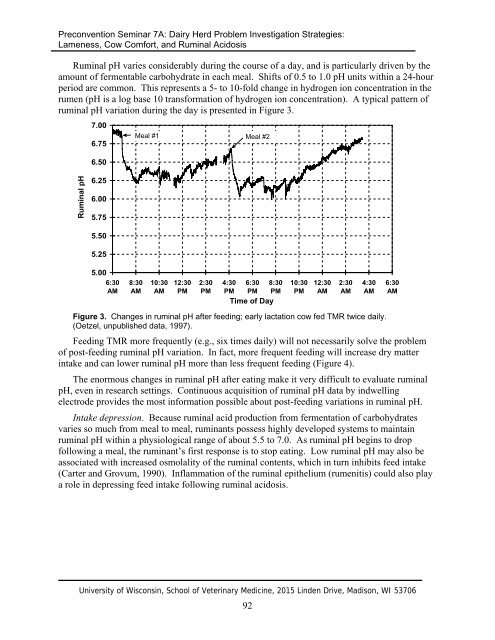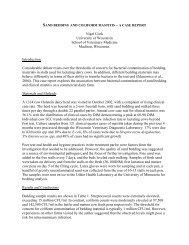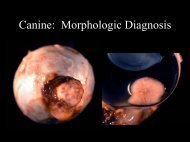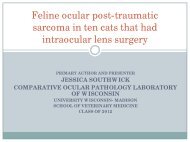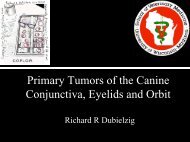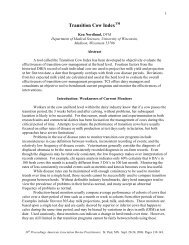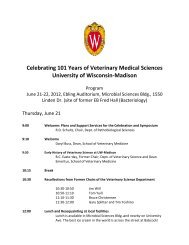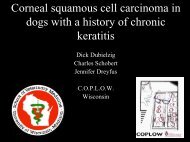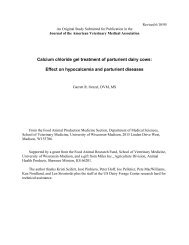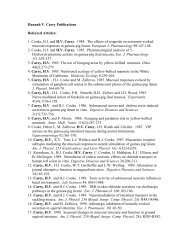Subacute Ruminal Acidosis in Dairy Herds - University of Wisconsin ...
Subacute Ruminal Acidosis in Dairy Herds - University of Wisconsin ...
Subacute Ruminal Acidosis in Dairy Herds - University of Wisconsin ...
Create successful ePaper yourself
Turn your PDF publications into a flip-book with our unique Google optimized e-Paper software.
Preconvention Sem<strong>in</strong>ar 7A: <strong>Dairy</strong> Herd Problem Investigation Strategies:Lameness, Cow Comfort, and <strong>Rum<strong>in</strong>al</strong> <strong>Acidosis</strong><strong>Rum<strong>in</strong>al</strong> pH varies considerably dur<strong>in</strong>g the course <strong>of</strong> a day, and is particularly driven by theamount <strong>of</strong> fermentable carbohydrate <strong>in</strong> each meal. Shifts <strong>of</strong> 0.5 to 1.0 pH units with<strong>in</strong> a 24-hourperiod are common. This represents a 5- to 10-fold change <strong>in</strong> hydrogen ion concentration <strong>in</strong> therumen (pH is a log base 10 transformation <strong>of</strong> hydrogen ion concentration). A typical pattern <strong>of</strong>rum<strong>in</strong>al pH variation dur<strong>in</strong>g the day is presented <strong>in</strong> Figure 3.7.006.756.50Meal #1 Meal #2<strong>Rum<strong>in</strong>al</strong> pH6.256.005.755.505.255.006:30AM8:30AM10:30AM12:30PM2:30PM4:30PM6:30PMTime <strong>of</strong> Day8:30PM10:30PM12:30AM2:30AM4:30AM6:30AMFigure 3. Changes <strong>in</strong> rum<strong>in</strong>al pH after feed<strong>in</strong>g; early lactation cow fed TMR twice daily.(Oetzel, unpublished data, 1997).Feed<strong>in</strong>g TMR more frequently (e.g., six times daily) will not necessarily solve the problem<strong>of</strong> post-feed<strong>in</strong>g rum<strong>in</strong>al pH variation. In fact, more frequent feed<strong>in</strong>g will <strong>in</strong>crease dry matter<strong>in</strong>take and can lower rum<strong>in</strong>al pH more than less frequent feed<strong>in</strong>g (Figure 4).The enormous changes <strong>in</strong> rum<strong>in</strong>al pH after eat<strong>in</strong>g make it very difficult to evaluate rum<strong>in</strong>alpH, even <strong>in</strong> research sett<strong>in</strong>gs. Cont<strong>in</strong>uous acquisition <strong>of</strong> rum<strong>in</strong>al pH data by <strong>in</strong>dwell<strong>in</strong>gelectrode provides the most <strong>in</strong>formation possible about post-feed<strong>in</strong>g variations <strong>in</strong> rum<strong>in</strong>al pH.Intake depression. Because rum<strong>in</strong>al acid production from fermentation <strong>of</strong> carbohydratesvaries so much from meal to meal, rum<strong>in</strong>ants possess highly developed systems to ma<strong>in</strong>ta<strong>in</strong>rum<strong>in</strong>al pH with<strong>in</strong> a physiological range <strong>of</strong> about 5.5 to 7.0. As rum<strong>in</strong>al pH beg<strong>in</strong>s to dropfollow<strong>in</strong>g a meal, the rum<strong>in</strong>ant’s first response is to stop eat<strong>in</strong>g. Low rum<strong>in</strong>al pH may also beassociated with <strong>in</strong>creased osmolality <strong>of</strong> the rum<strong>in</strong>al contents, which <strong>in</strong> turn <strong>in</strong>hibits feed <strong>in</strong>take(Carter and Grovum, 1990). Inflammation <strong>of</strong> the rum<strong>in</strong>al epithelium (rumenitis) could also playa role <strong>in</strong> depress<strong>in</strong>g feed <strong>in</strong>take follow<strong>in</strong>g rum<strong>in</strong>al acidosis.<strong>University</strong> <strong>of</strong> Wiscons<strong>in</strong>, School <strong>of</strong> Veter<strong>in</strong>ary Medic<strong>in</strong>e, 2015 L<strong>in</strong>den Drive, Madison, WI 5370692


